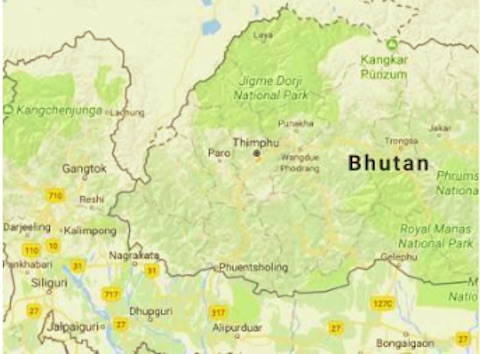Bhutan- China relations
This is a collection of articles archived for the excellence of their content. |
Doklam plateau
Chinese patrolling
Rajat Pandit, China’s road to Sikkim flashpoint with India, Jun 29, 2017: The Times of India

HIGHLIGHTS
The Doklam plateau is Bhutanese territory but China sends PLA men to the area
India is opposed to China’s attempts to construct a road on the Doklam plateau
China can militarily threaten Siliguri Corridor if the road is constructed
The Indian defence establishment is opposed to China's attempts to construct a road on the Doklam plateau leading right up to the Sikkim-Bhutan-Tibet tri-junction, which has emerged as the major flashpoint in the ongoing face-off between the two armies in the remote border region.
The Doklam plateau is Bhutanese territory but China, which calls it Donglang, regularly sends People's Liberation Army patrols to the area to lay claim to it. Beijing is desperate to incorporate the plateau in its adjoining Chumbi Valley, which is shaped like a dagger jutting into India, separating Sikkim from Bhutan, in southern Tibet for geo-strategic reasons.
The Indian establishment is obviously worried. For one, India will lose its "strategic advantage" in the region if the road is constructed.
"Though our troops don't hold the plateau, the watershed they hold dominates it. The Dhok La, in which we are present, opens into the Chumbi Valley," said a source.
Moreover, China can militarily threaten the strategically-vulnerable and narrow Siliguri Corridor just about 50-km away in West Bengal — the so-called "Chicken's Neck" that connects the rest of India with the north-east states — if China manages to extend the road up to the tri-junction.
"China already has a couple of roads coming up to a certain point in the Chumbi Valley. If one of them is extended till the trijunction, through what we consider is Bhutanese territory, it will help the PLA in military logistics and maneuverability, like rapidly moving artillery and other equipment, in the case of a conflict with India," said the source.
The ongoing troop confrontation, with some initial jostling and a scuffle, began early this month when Chinese troops brought in heavy earth-moving and road-construction equipment as well as manual labour to the area.
When Indian troops strongly objected to the move, the PLA soldiers destroyed two Indian bunkers in retaliation near the Lalten post and then shut down/closed the Nathu La Pass for the batch of pilgrims headed for the Kailash Mansarovar Yatra from there.
As reported by TOI earlier, the continuing stand-off has seen the two sides reinforce their positions with around 1,000 troops each. Senior Indian Army officers, including the general officer commanding of the 17 Division, are also camping in the region, with Army headquarters keeping a close watch on the "tense but under control situation".
Army chief Gen Bipin Rawat is himself slated to visit Sikkim on Thursday for a first-hand review of the ground situation. Coincidentally enough, the same region had seen intensive firing between the two armies in September 1967 before a ceasefire was declared. Since then, the 4,057-km long of Line of Actual Control stretching from Ladakh to Arunachal Pradesh has seen virtually no firing or violence between the rival troops despite regular "transgressions" and troop face-offs. Ironically, unlike the contentious borders at Ladakh and Arunachal Pradesh, the 220-km border between Sikkim and China is considered to be largely settled.